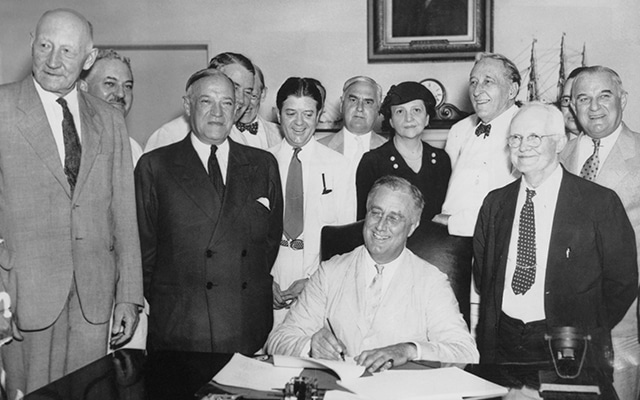Social Security
The Truth About Social Security: Exploding Five Destructive Myths

On August 14, our Social Security system will celebrate its 83rd birthday. Throughout its history – starting even before its enactment – a small but determined group of ideologues and extremely wealthy plutocrats have waged a campaign against Social Security.
From the beginning, they have weaponized myths and lies about Social Security. They have done so, because they have lost every honest debate about the program. And if the debate is fact-based and honest, they always will.
Their numbers have always been small. President Dwight Eisenhower labeled them “a tiny splinter group” whose “number is negligible.” Despite their small numbers, though, they are especially powerful today, because their wealth has given them oversized access to the mainstream media and the corridors of political power. That makes their lies especially dangerous.
The Truth About Social Security: The Founders’ Words Refute Revisionist History, Zombie Lies, and Common Misunderstandings (forthcoming, Strong Arm Press) will be released on August 14. The book methodically and thoroughly demolishes numerous destructive myths that are widely believed today. The following is the Cliff Notes version of a few of the myths shattered by The Truth.
Myth: Social Security is unaffordable, because people are living so much longer today.
Truth: Whether to expand or cut Social Security is a question of values, not affordability. At the end of the 21st century, Social Security will spend, as a percentage of GDP, not much more than it spends today. As the following graph illustrates, Social Security is unquestionably affordable.
Former Senator Alan Simpson (R-WY), a member of the Eisenhower-coined tiny splinter group, has aggressively pushed the false myth about our aging population supposedly making Social Security unaffordable. He has outrageously claimed that when Social Security was enacted, life expectancy “was 63. That’s why they set retirement age at 65.” Simpson’s statement is slanderous. He insinuates that President Franklin Roosevelt and the others who created Social Security were taking workers’ money while setting eligibility for benefits out of reach for most of them.
If that had been the case, the program wouldn’t have been so popular. In a survey conducted in 1936 – one year after the enactment of Social Security – 68 percent of those surveyed expressed approval for the new and untested program. By 1944, that percentage was a nearly unanimous 96 percent. That high level of support has been consistent to this day.
The truth is that although people, on average, are living somewhat longer today, the increase is not the decades that Simpson implies, nor was it unforeseen. The population is aging primarily because birth rates are low, not because of rapidly increasing life expectancies. As the wealthiest country in the world, at the wealthiest moment in its history, expanding Social Security’s modest benefits is completely affordable. Indeed, if we increased immigration to offset our low birth rates, Social Security would be even easier to afford.
Myth: Social Security is welfare, a “safety net.”
Truth: Social Security is insurance. It is not forced savings. It is not welfare. It is not a safety net. It is not an unearned windfall.
A safety net is something you fall into when you are in trouble. It catches you if you make a mistake on the high wire and find yourself hurtling toward the ground. You are, of course, glad the safety net is there, but falling into it is to be avoided, if possible. It is the sign of a mistake.
In contrast to a safety net, insurance is what prudent people purchase because they are aware of life’s risks and are responsibly and admirably planning ahead to protect themselves and their families against economic loss. Those on the high wire do not want to fall into their safety net, even though they are glad that it is there. In contrast, insurance is an asset prudent people purchase to protect themselves. The distinction is subtle, but important.
Just like private pensions, Social Security is insurance that we have earned. The false claim that Social Security is a government giveaway, that people are somehow receiving more than they have earned, has become a standard — but false — talking point of those who would dismantle the program. The goal is to mischaracterize Social Security in order to undermine its support.
It would be wonderful if Americans generously supported welfare willingly and compassionately. But that has never been our history. Welfare programs have trouble winning majority support. When they are enacted, they tend to incorporate harsh and punitive measures.
As long as we have poverty, welfare is essential. But let’s not let opponents of Social Security mislead us into thinking that our earned Social Security benefits are welfare or, more pejoratively, a handout.
Myth: Social Security was intended to be simply a foundation on which to build – part of a “three-legged stool.”
Truth: The metaphor of a three-legged stool for the nation’s patchwork of retirement income programs was first used in 1949 by an insurance executive whose company sold supplemental annuities. Today, it is used routinely, generally accompanied by the comment that Social Security was never intended to be a worker’s only source of retirement income. In fact, this widespread belief is wrong.
There is no evidence whatsoever that Roosevelt and his colleagues hoped and expected that employers would supplement Social Security for their employees and that workers would supplement their Social Security themselves with savings. In fact, there is substantial legislative history that the exact opposite was true.
Activists in the American old-age security movement — including those involved in the design of Social Security — were hostile to employer-sponsored pensions, viewing them as devices to control workers and believing them to be inherently insecure and unreliable. They also recognized that most Americans could not, then or in the future, save individually for their own retirement. They understood that insurance against the loss of earnings in old age, in the form of Social Security, was what was needed for a secure and independent retirement.
While Social Security’s benefits have never been fully adequate, the size of the benefits is easily explained by Roosevelt’s commitment to proceeding cautiously and incrementally. As he said in his message to Congress introducing the legislation, enactment and a solid start was “too precious to be jeopardized now by extravagant action.”
Social Security has now stood the test of time. Roosevelt’s goal of a solid start was achieved decades ago. Now is the time to expand Social Security’s benefits to make them fully adequate.
Myth: Social Security is out of date, needs to be modernized, and no longer works for the 21st century.
Truth: Nothing could be further from the truth. Social Security, which is as sound now as it was when enacted, continues to address extremely well a modern challenge: providing some measure of economic security in a modern, wage-based economy.
The truth is that Social Security, at base, is thoroughly modern. Just as in the 1930s, people today are dependent on wages to purchase the necessities of life. Therefore, in order to be economically secure, today’s workers need Social Security’s time-tested wage insurance. Its benefits should be expanded, not to modernize it, but as part of the incremental growth the founders envisioned.
Myth: Social Security has grown much larger than the founders intended. Indeed, they might not even recognize today’s Social Security.
Truth: The late Robert J. Myers, who was a lifelong Republican and remains, to this day, the longest serving chief actuary of Social Security, started his career in 1934, helping to develop what would become Social Security. In his landmark, exhaustive treatise, Myers states, “The level of [Social Security benefits payable to retired workers, once fully phased in] under the original 1935 law is actually significantly higher than under present law.”
More fundamentally, Roosevelt and the other founders had a bold, expansive vision of Social Security. They understood the phrase to encompass economic security that extended, in FDR’s words, “from the cradle to the grave.” Indeed, in a 1938 speech, founder Molly Dewson, one of the three members of the Social Security Board (later replaced by a single Commissioner), defined Social Security to include education, a good paying job, housing, and guaranteed universal health insurance, as well as insurance against the loss of wages in the event of unemployment, old age, short- and long-term disability and death.
In that 1938 speech, Dewson explained, “sickness compensation against loss of earning power during temporary or permanent disability [and] adequate medical care, including whatever medicines, treatment, and hospitalization are needed may still be mostly pious hope. But it is not a vain hope; both of these measures are already on the horizon.” She was, of course, talking about what we today call Medicare and paid medical leave.
If President Roosevelt and his colleagues were alive today, they would certainly recognize Social Security as fully consistent with their intent and their vision. They would undoubtedly be shocked, though, that so little progress has been made in the decades since 1935 when they laid down, in Roosevelt’s words, the “cornerstone in a structure which is being built but is by no means complete.”
It is time to expand Social Security, improve Medicare and expand it to cover everyone, raise the minimum wage and take other steps that build on that important cornerstone. To do so, it is imperative that the debate be honest.
In order to have an honest debate, we must see the truth. As the late Senator Daniel Patrick Moynihan (D-NY) memorably said during the last major debate over Social Security, “We are all entitled to our own opinion, but not our own set of facts.”
To ensure that we have shared — not alternative — facts, I hope everyone reads The Truth About Social Security: The Founders’ Words Refute Revisionist History, Zombie Lies, and Common Misunderstandings (forthcoming, 2018, Strong Arm Press).








